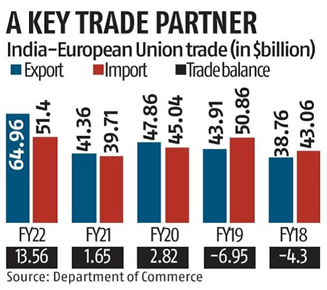

28th June 2022 (6 Topics)
Context
India and the European Union (EU) recently resumed negotiations, after a gap of over eight years, for a comprehensive free trade agreement.
About
India and the 27-nation bloc formally resumed negotiations on the proposed agreements on trade, investments and Geographical Indications (GI).
- India- EU IPA: The proposed India-EU Investment Protection Agreement (IPA) would provide a legal framework for cross-border investments to enhance the confidence of investors.
- India-EU GIs:GI pact is expected to establish a transparent and predictable regulatory environment, to facilitate trade of GI products including handicrafts and agri-commodities.
- A GI is primarily an agricultural, natural or a manufactured product (handicrafts and industrial goods) originating from a definite geographical territory.
- Typically, such a name conveys an assurance of quality and distinctiveness, which is essentially attributable to the place of its origin.
- The famous goods which carry this tag include Basmati rice, Darjeeling tea, Chanderi fabric, Mysore silk, Kullu shawl, Kangra tea, Thanjavur paintings, Allahabad surkha, Farrukhabad prints, Lucknow zardozi and Kashmir walnut wood carving.
Background:
- India had started negotiations for a trade pact with the EU in 2007, but the talks stalled in 2013 as both sides failed to reach an agreement on key issues, including customs duties on automobiles and spirits, and the movement of professionals.
- It is now officially known as the Broad-Based Trade and Investment Agreement but following talks between the top leadership last May, both sides agreed to resume on the FTA.
India-EU Relations:
- At $64.96 billion, the EU made for more than 15 per cent of India’s overall goods exports during the financial year 2021-22, while imports stood at $51.4 billion during the same time period.
- The EU is also India’s second-largest export destination and third-largest trading partner.
- The share of trade with the EU as compared to total bilateral trade has progressively shrunk in recent years.
- When the strategic partnership was initiated in 2004, export to the bloc was 21.8 per cent of all exports; import was 17.3 per cent of all inbound trade.

Challenges:
- Pursuit of self-reliance has been accelerated by the Covid-19 crisis under the Atmanirbhar Bharat Mission. This is perceived by the European Union as India's “protectionist stance”.
- India may find it difficult to meet the sustainable standards in labour and environment on which the EU now lays greater emphasis.
Significance:
- India seeks to signal that it means business and is not averse to signing trade agreements after it opted out of the Regional Comprehensive Economic Partnership (RCEP) at the last moment.
- The EU, in turn, wants to diversify its value chain away from China to India and, hence, there is interest on its part also to have a trade agreement with India.
About Free Trade Agreements (FTA)
- The FTA negotiations are part of India’s broader strategy to forge balanced trade agreements with key economies and revamp existing trade pacts to improve trade and investment.
- India earlier this year has concluded FTAs with Australia and the UAE in a record time. The FTA talks with Canada and the UK are also underway.
|
Types of Regional Trading Agreements: Regional trading agreements vary depending on the level of commitment and the arrangement among the member countries.
|


